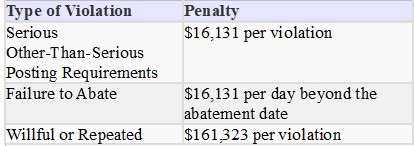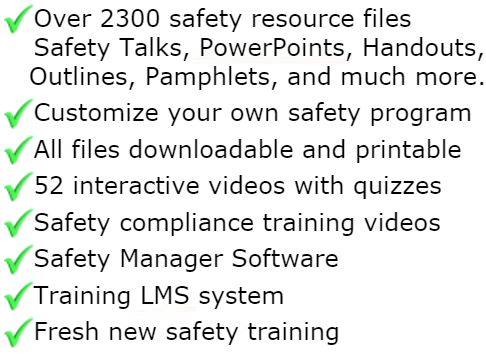
Machine & Equipment Safety
The Machine Guard Program is designed to protect Employees from hazards of moving machinery. All hazardous areas of a machine shall be guarded to prevent accidental "caught in" situations. References: General Requirements for all Machines (29 CFR 1910.212), Woodworking Machinery (29 CFR 1910.213), Abrasive Wheels (29 CFR 1910.215), Power Presses (29 CFR 1910.217), Power Transmission (29 CFR 1910.219).
It is crucial to understand why machine and equipment safe guards are to be used on machines. An operator or maintenance worker must be informed as to the location of the safe guards on the machines, and should also be provided information on why safe guards protect them and what hazards they protect them from.
An operator or maintenance worker also should be trained on how to remove machine and equipment safe guards from the machines and also to understand in what circumstances guards can be removed. Workers need to be trained in procedures to follow if they notice guards are damaged, missing or inadequate.
An operator or maintenance worker should be provided with a dress code. For example; no loose fitting clothing or jewelry. These items could easily be caught in the equipment or machines. From the simplest hand tool to the most complex machinery… operational safety hazards exist with any equipment.
Machine & Equipment Hazardss
Electrical Hazards – equipment that uses electricity as a power source is a potential electrocution hazard. Check power cords, switches and connections for exposed wires or broken parts.
Amputation & Caught-in Hazards – machine guards on equipment are installed to protect our employees from moving parts. Of course if they have been removed during maintenance or adjustment they will no longer provide protection. Check equipment every day to ensure that all guards are in place.
Chemical Hazards – processing equipment that uses chemicals can be sources of numerous hazards. Leaks can cause slip hazards as well as possible exposure to harmful chemicals. Hoses that leak could create a respiratory problem from vapors
Sharp Edges – simply walking past machinery may be hazardous if sharp edges are not guarded - check equipment mounting brackets, sign edges and control boxes to see if sharp edges are present.
Eye Hazards – tools and equipment that create chips, sparks or dust are potential eye hazards. These types of eye hazards are generally controlled by safety glasses, goggles and face shields. Check eye protection your workers use to make sure they are not broken, scratched and are the correct type for the hazard. As a minimum, anyone who uses hand or power tools should wear safety glasses.
PPE – personal protective equipment should be considered a secondary line of defense against equipment hazards. Employees need to know how to properly select, use and clean any PPE they use. PPE does wear out and has limitation on the level of protection against hazards – your workers should know these limitations.
Training – probably the most effective protection you can give your workers is good operational and safety training. A worker who knows how to recognize hazards can then use his or her training to control the situation and avoid exposure to unsafe conditions. If you expect your people to safely operate equipment, they must first be trained to understand the operating principles, equipment controls and possible hazards to themselves and others.
Maintenance workers need to be provided information on up-to-date machines that have been serviced, and they should maintain a record log of this information.
Maintenance workers must also know when to LOCK OUT the machines. This is extremely critical when repairs are being done on the machine. Maintenance workers should also be using safe equipment when doing repair work and they should insure the equipment itself is properly guarded. You are much more productive working safely and obeying safety rules. All we ask is for you to perform your job professionally and safely.
All materials in the members area for this topic index

GET INSTANT ACCESS
to THE MEMBERS LIBRARY
Safety materials created by safety professionals.
Access to the Safety Manager software.
Wide variety of safety videos and courses.
**Brand New** Safety Training Management System
Pre-Made Safety Materials Ready For Use
Created by experienced safety professionals & risk consultants. Saving you time, money, and risk of injuries.
95% of the work already done.
Below are the maximum penalty amounts, with the annual adjustment for inflation, that may be assessed after Jan. 15, 2024. (See OSHA Memo, Jan. 8, 2024).

**New OSHA HEAT 90 DAY**
>>Download Free HERE<<
**New 2024 OSHA 300 Form**
>>Download Free HERE<<
**Brand New**
Free with full membership subscription
Training LMS System
Ask The Safety Consultant
Safety Equipment Deal Finder

“SafetyInfo.com is the first go-to website for safety professionals and companies to use in establishing a solid safety program"
-Mike McKenzie, Certified Safety & Health Manager (CSHM), McSafety Solutions™
Note: You must have a full subscription to the Safety Library in order to use this material. Any use outside of your organization, for resell, or without an active membership is strictly prohibited and may result in prosecution under copyright infringement laws. Please contact us first, if you would be interested in reselling or using our materials for reproduction.
Inside the Members Library
Topic Index
Accident Prevention
Air Quality
Asbestos
Bloodborne Pathogens
Boilers
Chemical Safety
Compressed Gas
Confined Space
Construction
Construction Worksite
Cranes & Slings
Driver / Fleet Safety
Drug Free Workplace
Electrical
Emergency Management
Engineering Safety
Environmental
Equipment
Ergonomics
Fall Protection
Fire Safety & Prevention
First Aid
Flammable Materials
Forklifts
Hazard Communication
Hazardous Materials
Hearing Protection
Heat Stress
Hot Work
Housekeeping
Job Safety Analysis
Laboratory
Ladders
Lead
Lockout-Tagout
Machinery & Equipment
Material Handling
MSDS (SDS)
Medical & First Aid
Occupational Health
Office Safety
Off the Job Safety
Personal Protection
Process Safety
Record Keeping
Respiratory Protection
Silica Safety
Rules & Policies
Signs & Labels
Slips, Trips & Fall
Training
Terrorism Programs
Tool Safety
Vehicle & Driver
Violence Programs
Welding & Hot Work
Training Videos
Library Index
Training Materials
Videos/Courses
Talks
Articles
PowerPoint
Handouts
Training Overheads
Quizzes
Supervisor Briefs
Management Briefs
Safety Sessions
2 Minute OSHA Safety Talks
Pamphlets
First Aid Training
Supervisor Training
Hazardous Materials
Bomb Threat
Crossword Puzzles
Biological Agents
Forms & Documents
Forms
Checklists
Audit Guides
Inspections Guides
Signs & Labels
Environmental Audit Guides
Recordkeeping - OSHA 300
Sign & Label Maker
Safety Management Resources
Safety Manuals/Written Programs
Ergonomic Programs
Emergency Plans
Process Safety Management
Construction Safety
Occupational Health
Environmental
Topic Sheets
DOT Fleet-Driver
Hazardous Materials
Chemical Safety
Drug Free Workplace
Terrorism Programs
Development Guides
Safety Manager Software
Safety References & Graphics
Technical Safety Information
Posters
Topic & Fact Sheets
Development Information
Job Specific Safety Rules
Terrorism
Calculators
Safety Comic Strips
New Safety Training System
Schedule and train your employees with our materials. Add unlimited amount of employees. Record all progress and issue certificates. For group and individual training sessions.

